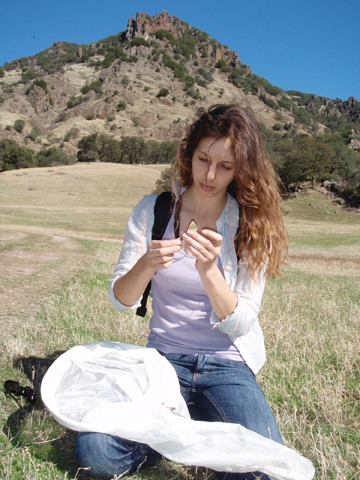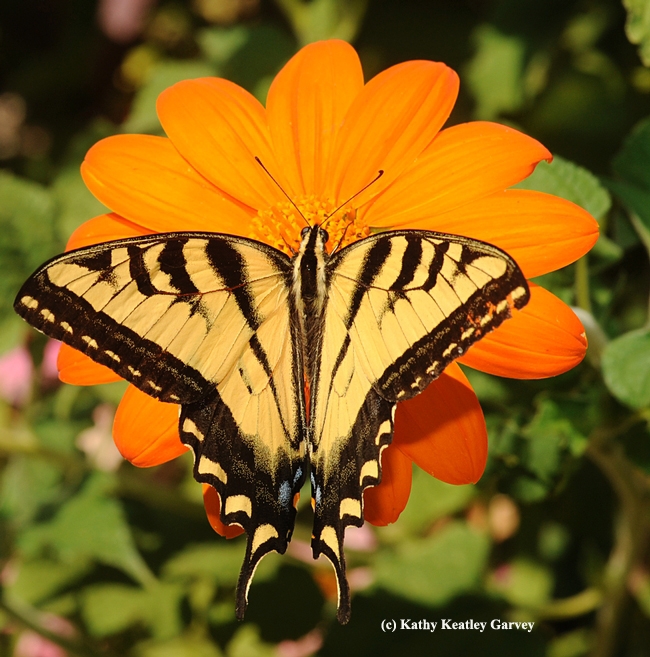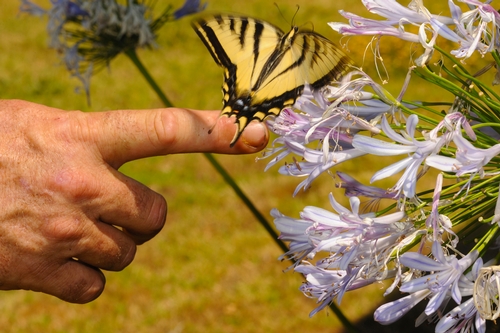- Author: Kathy Keatley Garvey

That's when butterfly expert Art Shapiro, professor of evolution and ecology at UC Davis, will be speak at the Northern California Entomology Society meeting, to be held at the Harry H. Laidlaw Jr. Honey Bee Research Facility on Bee Biology Road, UC Davis.
The meeting will begin at 9:15 a.m. with registration for club members and guests, and conclude at approximately 2:30 p.m. The group, which meets three times a year, is comprised of university faculty, researchers, pest abatement professionals, students and other interested persons.
Shapiro will lead off the program at 9:45 a.m. with his talk on “History of the Sacramento Valley Butterfly Fauna.” A noted butterfly expert, he has monitored butterflies for more than 35 years in the Central Valley and maintains Art's Butterfly World website.
Chemical ecologist Steve Seybold of the USDA Forest Service, Davis, and an affiliate of the UC Davis Department of Entomology, will speak on “Goldspotted Oak Borer in California” at 10:30 a.m.

Following the lunch from noon to 1 p.m., Jason Leathers of Pest Detection/Emergency Projects, California Department of Food and Agriculture (CDFA), will cover “Pest Control Approaches and Evaluations on Success of 2012 Insect Eradication Programs in California.”
At 1:45 p.m., Stephen Brown, CDFA, and Anthony Jackson, Animal and Plant Health Inspection Service (APHIS), USDA, will discuss “California and Federal Regulations Concerning Importing Living Plant Pests.”
The society meets three times a year: the first Thursday of February at the California Department of Food and Agriculture (CDFA), Sacramento; the first Thursday of May, at the Harry H. Laidlaw Jr. Honey Bee Research Facility, UC Davis; and the first Thursday of November in the Contra Costa Mosquito and Vector Control District conference room, Concord.
Membership is open to the public; dues are only $10 year. President is Robert Dowell, a staff environmental scientist at CDFA.
More information about the meeting is available from Extension apiculturist Eric Mussen of the UC Davis Department of Entomology. Serving as the society’s treasurer, he can be reached at ecmussen@ucdavis.edu or by (530) 752-0472.

- Author: Kathy Keatley Garvey

And a free one, at that.
UC Davis graduate student Melissa Whitaker, who is studying for her doctorate with noted butterfly expert Arthur Shapiro, distinguished professor of evolution and ecology at UC Davis, has just created an app or application for iphones, ipods and ipads.
It's called Butterfly Guide: Butterflies of the Sacramento Valley, Delta and San Francisco Bay Area. Click on Itunes to download it.
So if you're from the Sacramento or San Francisco area, and see a butterfly fluttering around, you can identify it by consulting this free app. Western tiger swallowtail? Check. That would be Papilio rutulus. Monarch butterfly? Check. Danaus plexippus. Gulf fritillary? Check. Agraulis vanillae.
Her app includes 117 species of butterflies, complete with photos, descriptions, common names, scientific names and family names. Shapiro, her key source of information and inspiration, maintains a comprehensive website that includes data he's collected for more than three decades. He's the author of Field Guide to Butterflies of the San Francisco Bay and Sacramento Valley Regions.
Whitaker engaged two computer science undergraduates, Joey Jiron and Bryan Maass, for the app development.
Whitaker, who's from Colorado but claims California as home, says she's relatively new to the butterfly scene. "Always a lover of nature and natural history education, I quickly arrived at butterflies as ideal study organisms for my PhD research," she says.
Whitaker describes the app as a "mobile tool for natural history education and biodiversity informatics, using the butterflies of the region."
Her website details how to use the guide and how to share data. She's hoping to encourage users to become citizen scientists.
Whitaker is especially interested in the teaching aspect. "Butterflies are absolutely terrific models for education in the science classroom, and capture the attention of all ages," she says on her website. "They can be used to teach many biological concepts: mimicry, conservation, species interactions, biodiversity, migration, ecology, evolution, life history development, and on and on! They can also be great tools for inspiring people to spend more time outside observing their natural (or semi-natural) surroundings. With this in mind, we hope teachers and educators will find ways to incorporate butterfly monitoring into their classrooms and will share their curriculum and ideas. For great ideas for biodiversity lesson plans check out Project Noah's Education page."
"Our long-term vision for this project is that The Butterfly Guide will provide a template for The Lizard Guide, The Urban Spider Guide, The Wildflower Guide—a whole series of guides!" she says. "With that in mind we can provide all development materials to folks who want to create their own educational, community-driven and non-commercial (free!) field guide apps."
The National Science Foundation funded the project through its REACH-IGERT program. REACH is an acronym for REsponding to RApid Environmental CHange (REACH), while IGERT is Integrative Graduate Education and Research Traineeship.

- Author: Kathy Keatley Garvey
Don't look now, but a garden spider almost grabbed a tiger by the tail.
The tiger? That would be the Western tiger swallowtail, Papilio rutulus.
The ragged wings of the butterfly (below) show signs of a close encounter with a predator--maybe another spider, a praying mantis or a bird.
The Western tiger swallowtails are drop-dead gorgeous. Sporting a yellow-and-black wingspan of 2.75 to 4 inches (when not tattered by a predator!), these butterflies attract attention as they glide around gardens and parks and in riparian forests.
This is one of the butterflies that distinguished scientist Arthur Shapiro, professor of evolution and ecology at UC Davis studies. Check out his amazing butterfly website.
LiveScience, in partnership with the National Science Foundation, recently showcased him in a feature story, "Passion for Butterflies Becomes a Study in Climate Change Impact."
You'll want to read how Shapiro first became involved in the wonderful world of butterflies, and how that passion led to a massive butterfly data collection he launched more than 40 years ago.
Despite "the high altitudes, rigorous walks and over cooperative weather, he's still going strong, exploring mountains across central California, pen and notebook in hand," wrote Ayesha Monga Kravtz of the National Science Foundation.
"Through phylogeography, Shapiro is trying to reconstruct the history of the high-mountain butterfly faunas both on the West coast of North America and in the southern parts of South America, such as Argentina and Chile," Kravtz wrote. "By reconstructing the history of these faunas, where they came from, how they moved and when, scientists and researchers can make predictions as to how the fauna will respond to climate change in the future."
And, as Shapiro told Kravtz: "The past is the key to the future."
Indeed it is. And that would include the comings and goings of the Western tiger swallowtail.


- Author: Kathy Keatley Garvey
Sometimes you can't get within 20 feet of a Western tiger swallowtail butterfly (Papillo rutulus).
Sometimes it's a matter of inches.
That was the case this morning at the Häagen-Dazs Honey Bee Haven at the University of California, Davis, when a lone Western tiger swallowtail took a liking to the Mexican sunflowers (Tithonia rotundifolia).
The spectacular butterfly, one of the most recognizable of all butterflies, glided to the patch of Mexican sunflowers (so named because they originate from Mexico and Central America) sipped a little nectar, and then fluttered away, only to return again.
Not once, but dozens of times.
The haven, a half-acre bee friendly demonstration garden planted next to the Harry H. Laidlaw Jr. Honey Bee Research Facility on Bee Biology Road, west of the main campus, features ornamentals, vegetables, fruits and nuts (almonds), as well as art work from the UC Davis Art/Science Fusion Program. It's open from dawn to dusk; admission is free.
The Mexican sunflowers, family Asteraceae, grow a towering eight feet, and are as orange as the jerseys of the San Francisco Giants. Today they attracted scores of honey bees, sunflower bees, hover flies, sweat bees, and yes, a spotted cucumber beetle (pest).
However, the "tiger" in the Tithonia stole the show.


- Author: Kathy Keatley Garvey
Tame that tiger.
Wilton beekeeper Brian Fishback, president of the Sacramento Area Beekeepers' Association, stopped Friday at the Harry H. Laidlaw Jr. Honey Bee Research Facility, UC Davis, and a friendly Western tiger swallowtail greeted him.
At least, it seemed quite friendly.
Fishback and Laidlaw staff research associate Elizabeth “Liz” Frost paused to watch the butterfly (Papilio rutulus) glide in and out of the flower garden in front of the facility.
Fishback held out his hand. The butterfly obliged and touched down for just a moment.
This year is a good year for Western tiger swallowtails.
There’s an outbreak--or an elevated population--in the area, says noted butterfly expert Arthur Shapiro, professor of evolution and ecology at UC Davis. “I’ve seen as many as 11 a day in Davis recently, and the outbreak ranges from as far west as Vallejo and as far east as Reno.”
This is the second year for elevated populations of the tiger, Shapiro says. The epicenter seems to be Davis.
The colorful butterfly visits a variety of hosts, including California yerba santa, milkweed, lilies, lilacs, coyote mint, California buckeye, sycamore, privet and sweet gum.It doesn't mind being around the 6 million honey bees (from 110 hives) in the apiary at the Laidlaw facility, either.





